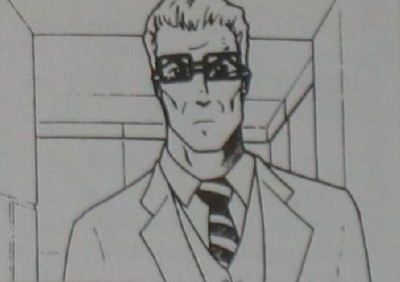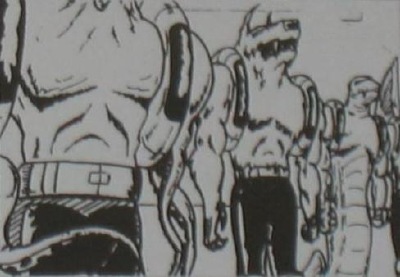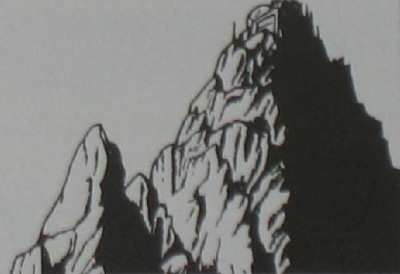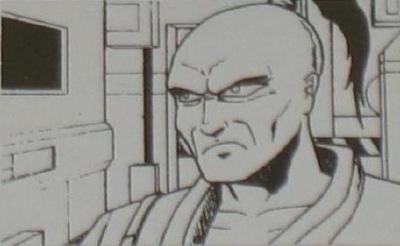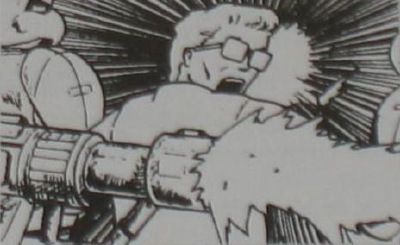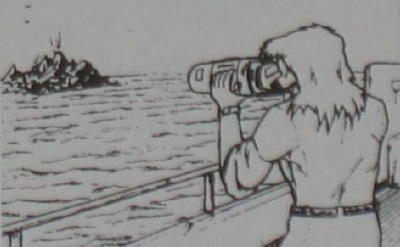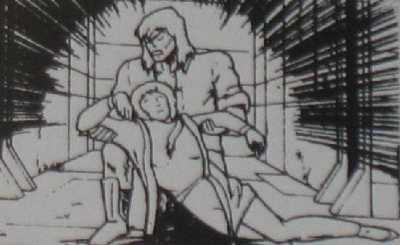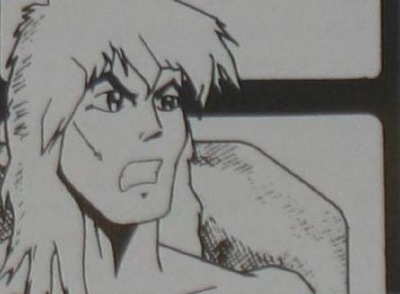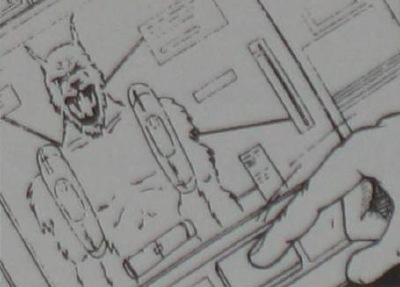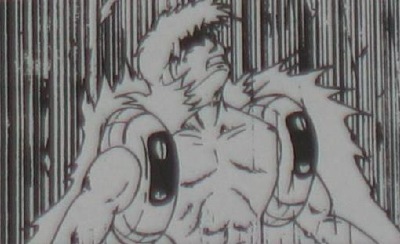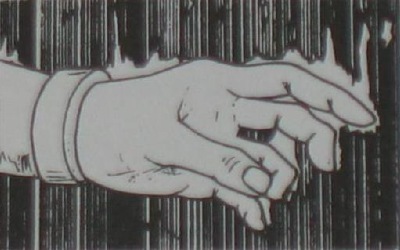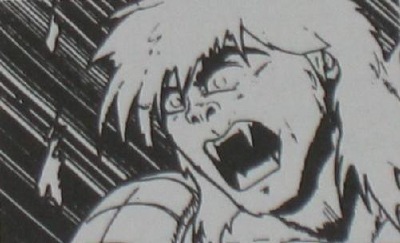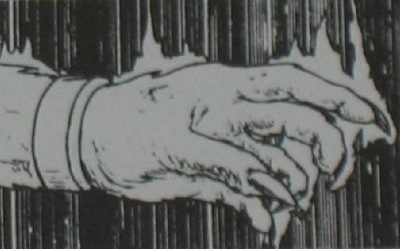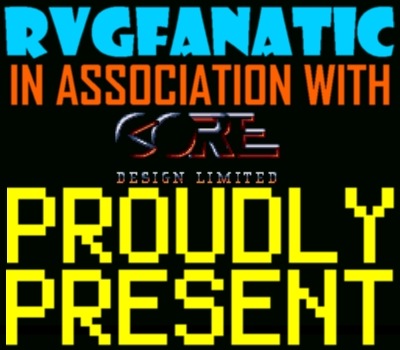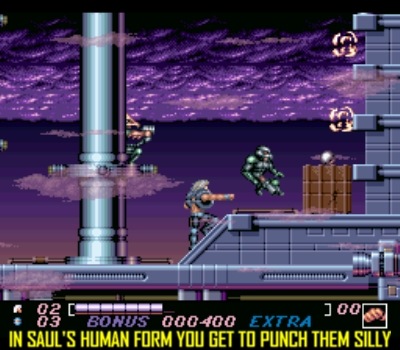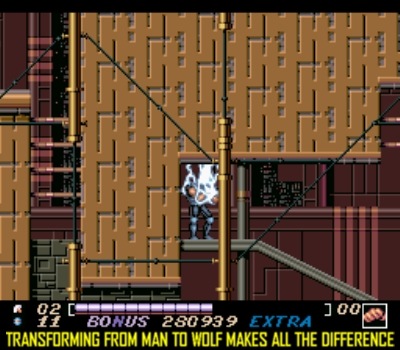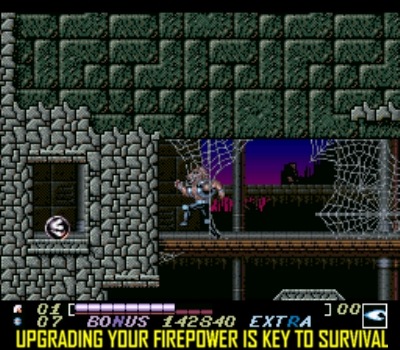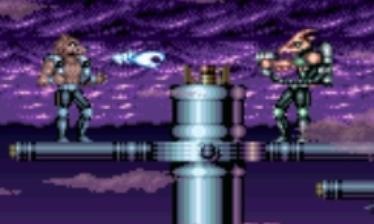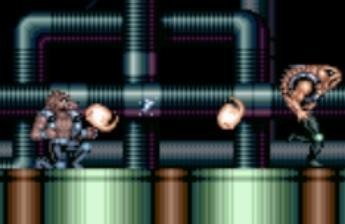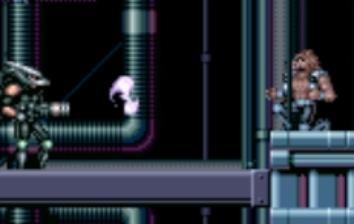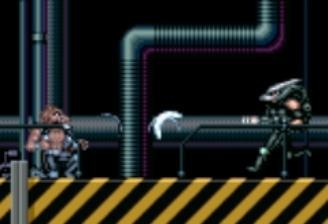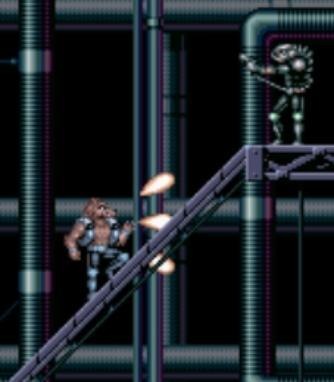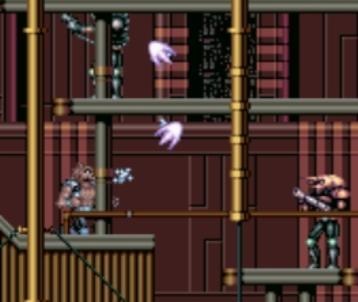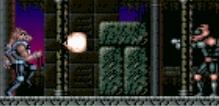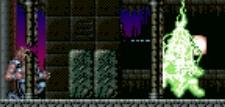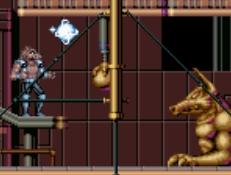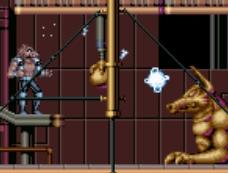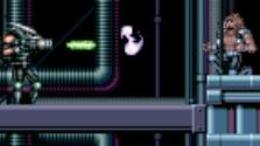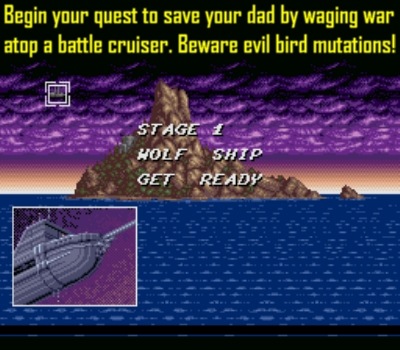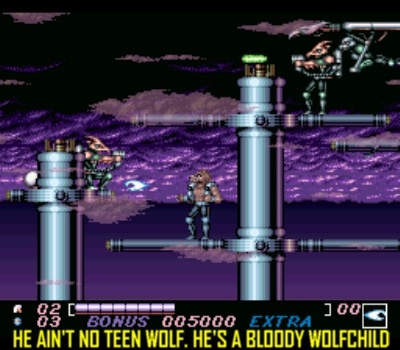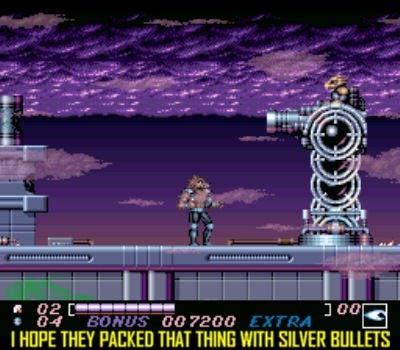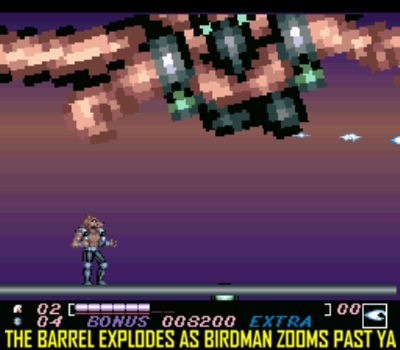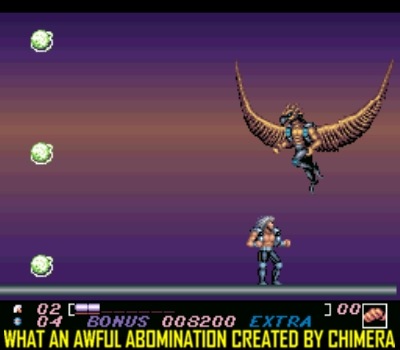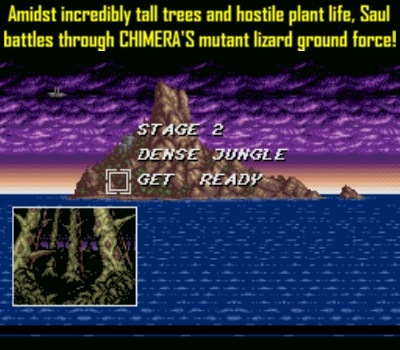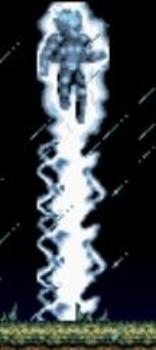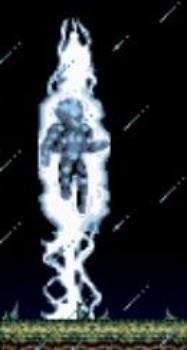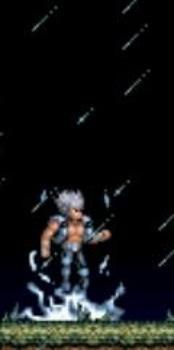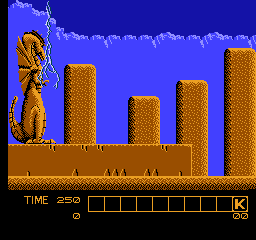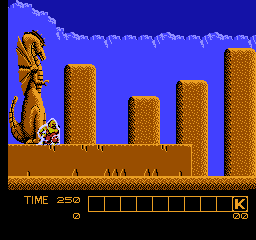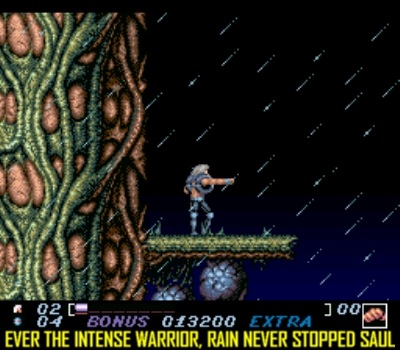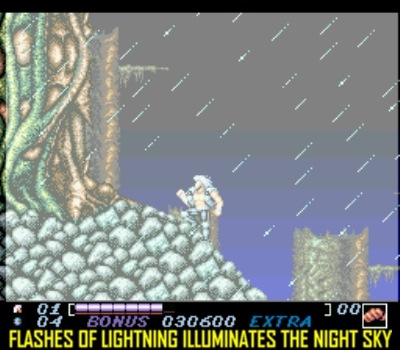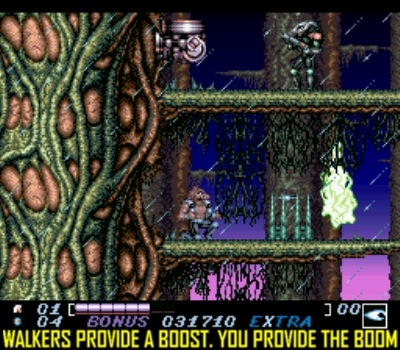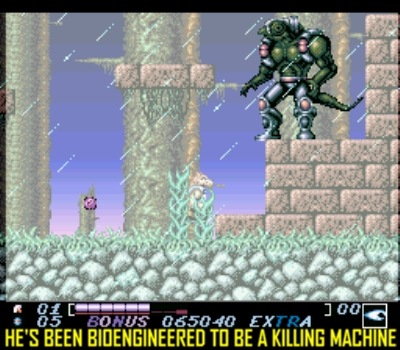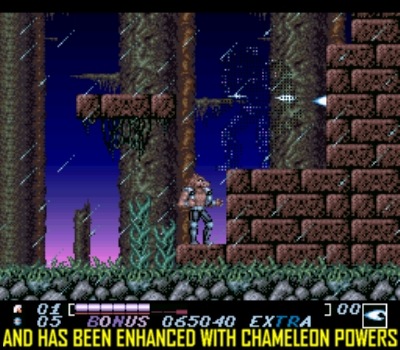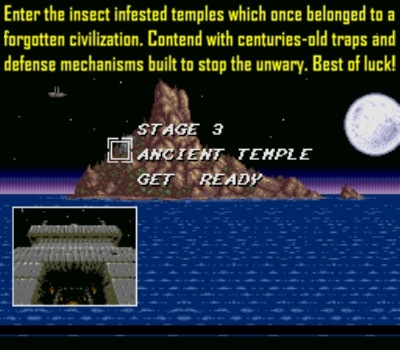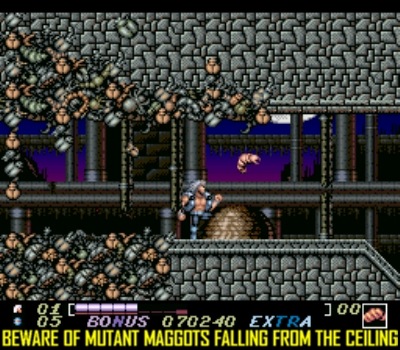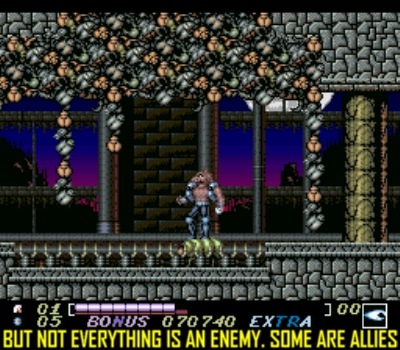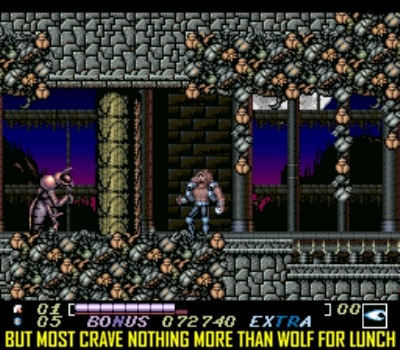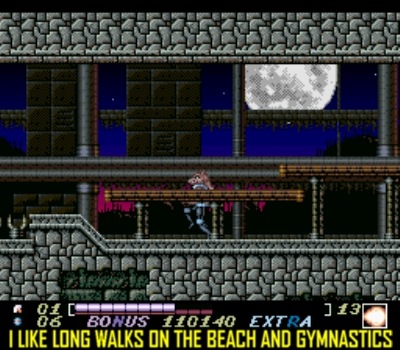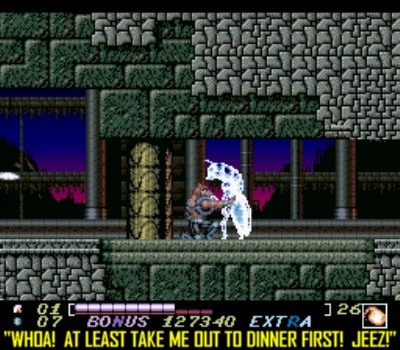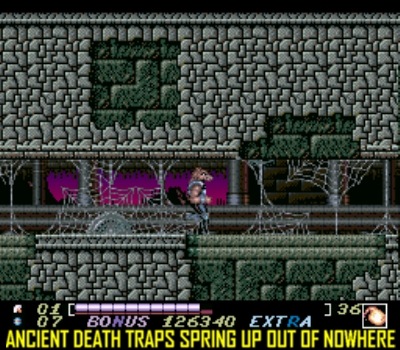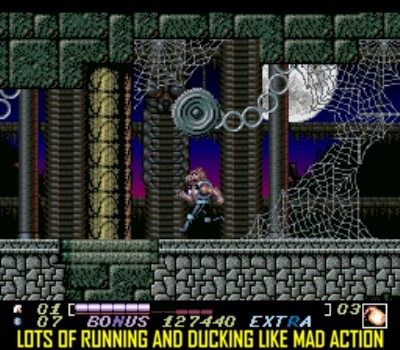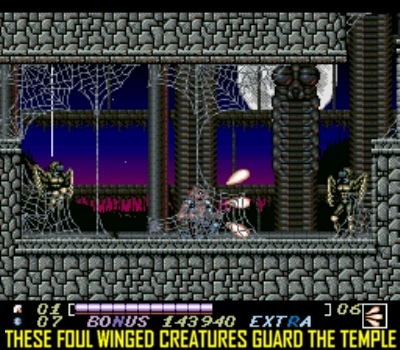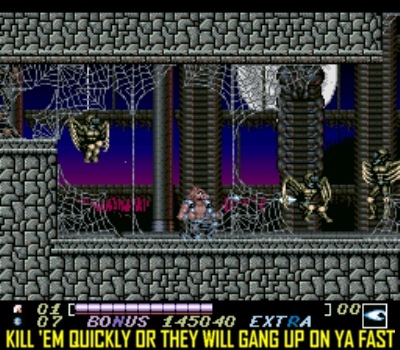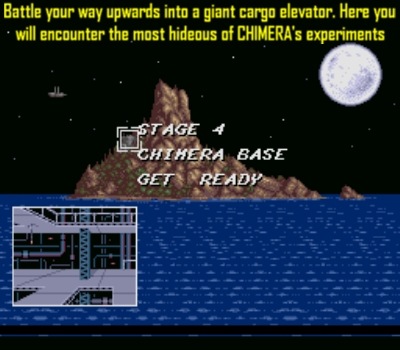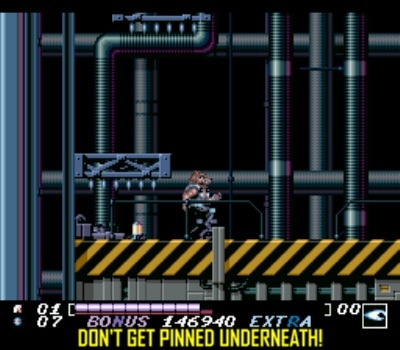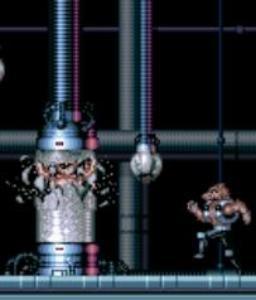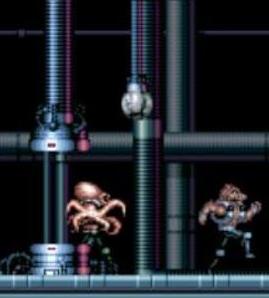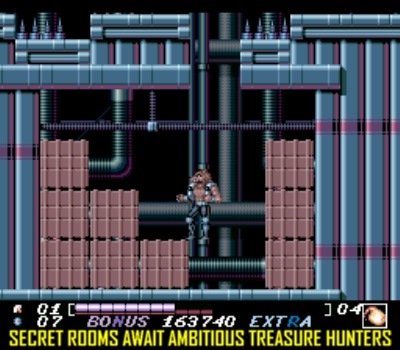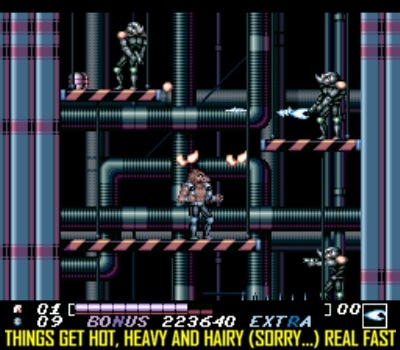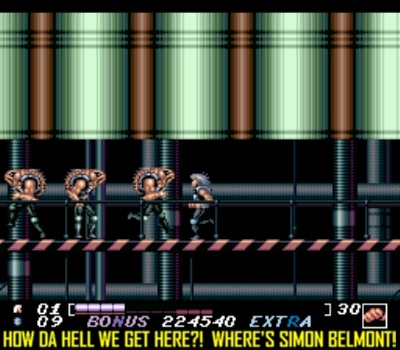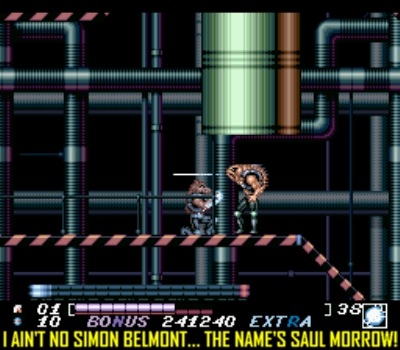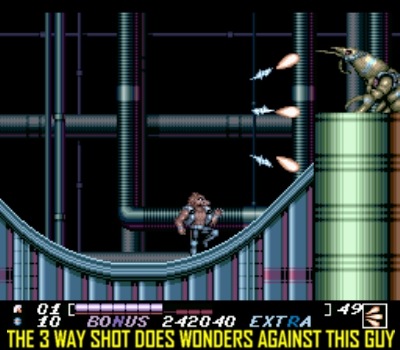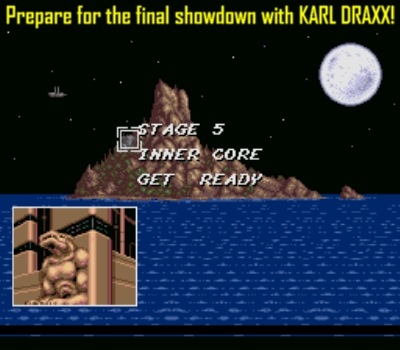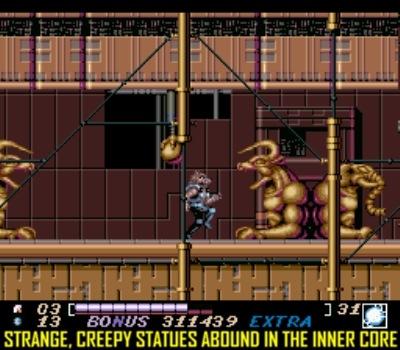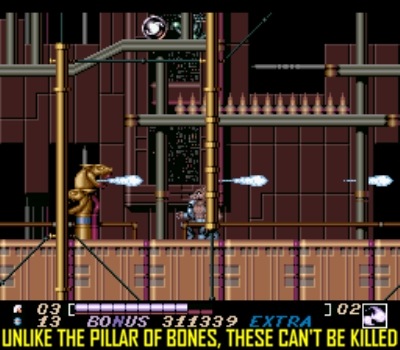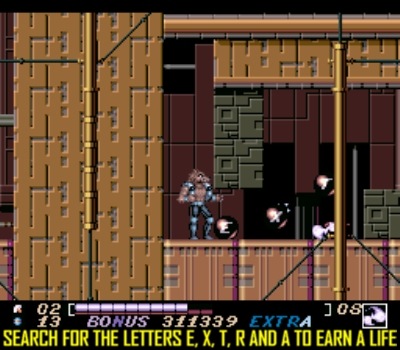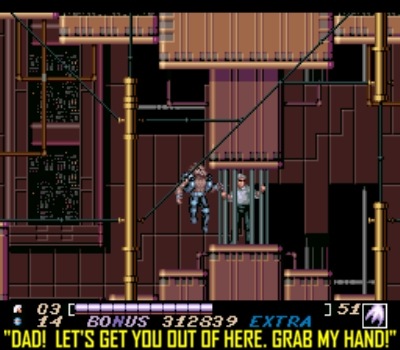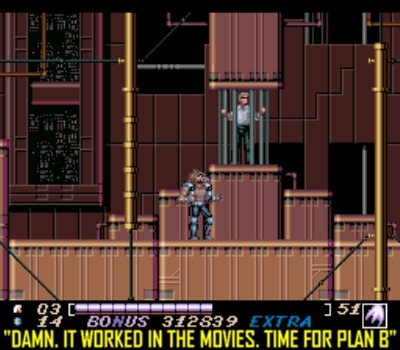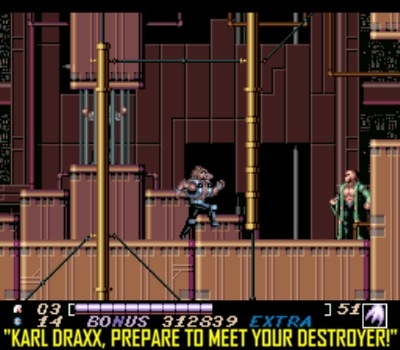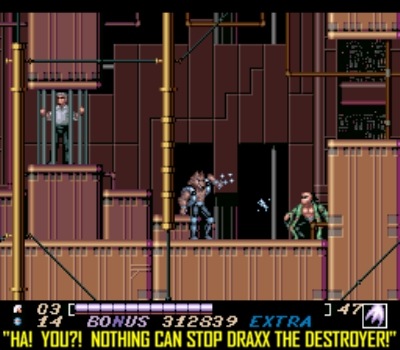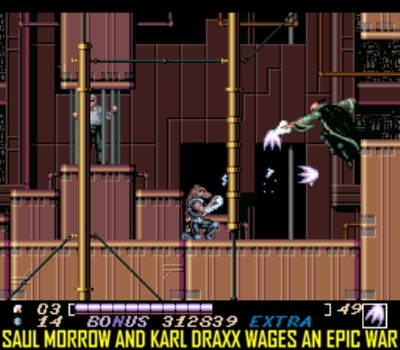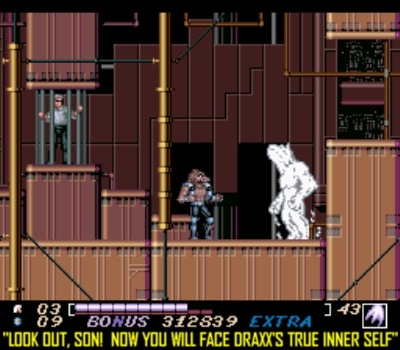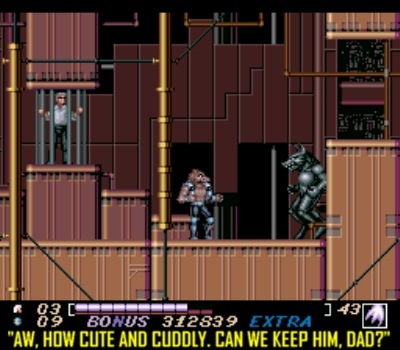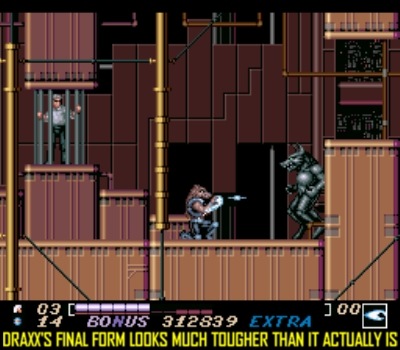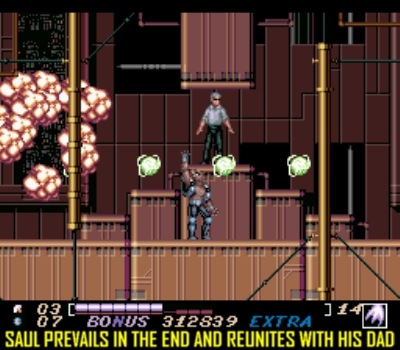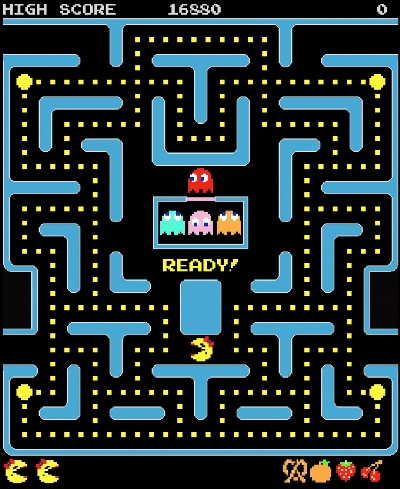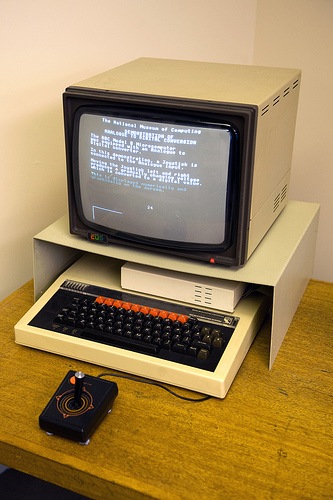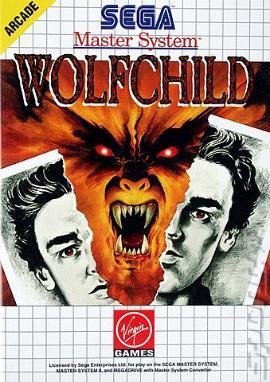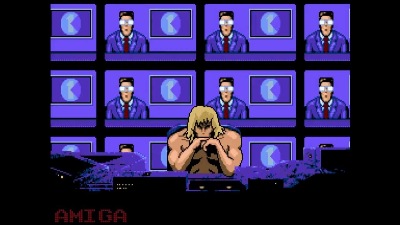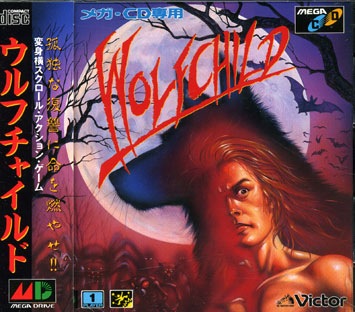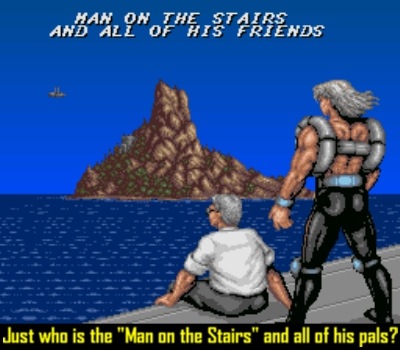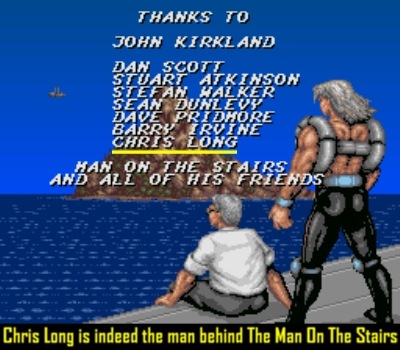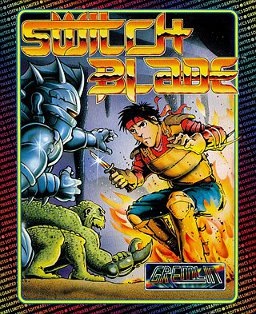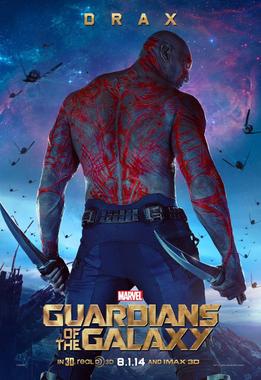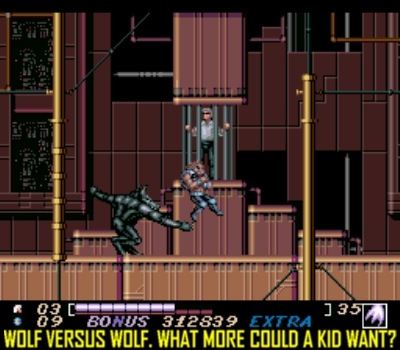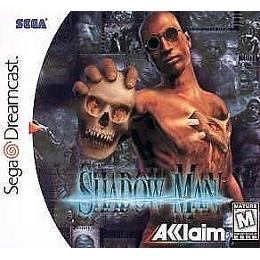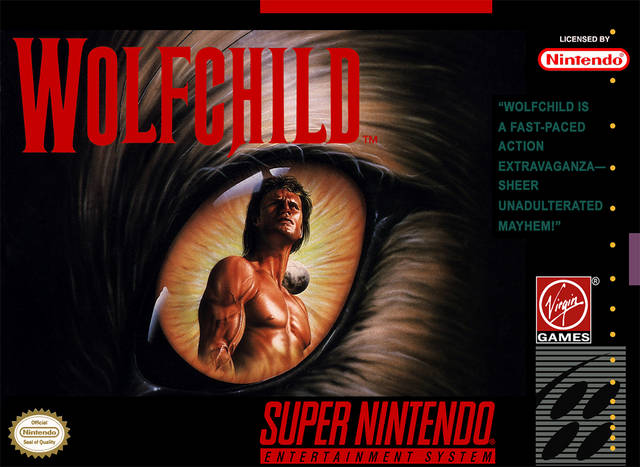
The ’90s was a time fraught with platforming action titles. For every heralded classic, there were about 50 others ranging from bad to good. And many of those games got lost in a vastly overcrowded genre. It was the “me too” era where seemingly everybody and their brother were trying to cash in on the platforming craze. Enter Wolfchild. It’s a perfect example of a game that got lost in the shuffle back in the summer of 1993. It’s forgotten to time, but not to RVGFanatic. Today I am proud to add this game to my SNES review library. It’s not the best game by a long shot, but I always enjoy highlighting lesser known titlesu and this one fits that bill quite nicely. Also, in late 2014 I was able to interview Simon Phipps. He worked extensively on Wolfchild and dropped some excellent knowledge on the game which you can read at the bottom of this review.
THE “TAIL” OF THE TAPE
![['Tail' of the tape? Oh boy we're off to a good start -Ed.]](http://rvgfanatic.com/wordpress/wp-content/uploads/2017/02/Wolfchild.jpg)
[You know what happens when you steal Chris Jericho’s gimmick? Huh?! Do ya? You wanna know what happens? I’ll tell ya what happens… Steve from RVGFanatic, YOU JUST MADE THE LIST! -Chris Jericho, probably]
!["YOU STUPID IDIOT!" [I like this Chris Jericho guy -Ed.]](http://rvgfanatic.com/wordpress/wp-content/uploads/2017/02/ShockedJericho2.gif)

In that topic the name of Simon Phipps came up. He’s the man behind Wolfchild. I sent him an email in 2008 asking him if he would be available for an interview about his game. He generously agreed. But then my life got busy and I never sent him my questions. For more than half a decade I’d meant to but just never did. Finally, in the summer of 2014 I emailed Simon to see if he was still around, and in the chance that he was, would he be game to finish a proposed interview some six years in the making. Remarkably, he was still at his hotmail account from 2008 and he was kind enough to follow through. That interview comes at the bottom of this review and to this day, with all due respect to Brian Greenstone’s interview from Harley’s Humongous Adventure, remains my favorite Q&A that I’ve personally conducted. Simon went into great detail about Wolfchild and shared some quirky facts. Thanks, Simon!
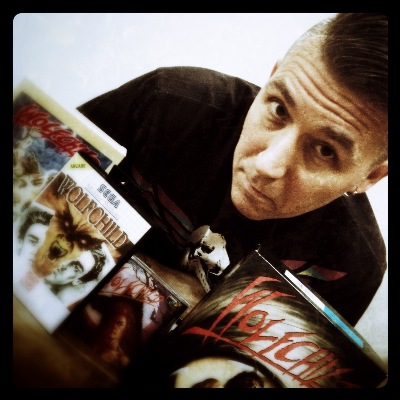

THE STORY GOES…
For three decades Kal Morrow has been regarded as one of the world’s leading scientists, pushing back the barriers of biogenetic research with a force that few have equaled. His many medical breakthroughs have resulted in the eradication of several major fatal diseases and have increased human longevity by over forty years. His research has had far reaching effects, touching the areas of agriculture, deep sea and space exploration, as well as sport and military technology. For the past five years, Morrow has worked for the government perfecting advanced gene splicing techniques which allow the alteration of the human form in ways never before imagined.
He’s also worked on the development of psychic powers such as telekinesis and levitation. His life’s project has been anchored around the combination of human and animal physiology to create a new breed of lifeform. A perfect war machine augmented by animal instinct within a body that is immune to pain and capable of incredible feats of physical strength and psychic power. Totally adaptable to any possible environment, such a force would be virtually unstoppable. It would be the ultimate response to terrorism and crime.
Morrow’s research has been conducted at the Keppler Observatory on a remote island somewhere in the Southern Pacific. His location has been kept secret due to the sensitive nature of his work. And because of it his family, his wife and their two sons have lived with him under constant guard. However, not long ago his whereabouts were uncovered by the international terrorist organization known as CHIMERA.
Led by the fanatical and maniacal Karl Draxx, a sociopath possessing natural telekinetic abilities, CHIMERA has perpetrated many acts of terrorism throughout the world. Analysis of Draxx’s personality and the nature of these incidents has led experts to one conclusion: through CHIMERA, Karl Draxx is pursuing his megalomaniac fantasy of world domination. There’s a reason why he was recently moved into the top slot of the FBI’s Most Wanted.
Until recently it was never believed that Draxx could ever realize his dream. 36 hours ago CHIMERA made a sweeping attack on the Keppler Observatory and kidnapped Kal Morrow. The attack was swift and vicious, overwhelming Morrow’s security force. There were no survivors. Morrow’s wife and eldest son were both brutally murdered before his very own eyes.
Kal Morrow’s youngest son, Saul, was at sea conducting oceanographic research for his father when the attack took place. By the time he returned to the island CHIMERA was long gone, leaving only the observatory behind in complete utter ruin.
Frantically he searched for his family… before finally discovering his mother’s body slumped in a dimly lit hallway. Through tears of grief and anger Saul clutched her broken form, swearing vengeance on the perpetrators of this terrible, unforgivable act.
Making his way to his father’s secret laboratory, concealed deep below the island, he reviewed security tapes of the attack. His rage grew as he watched his father being dragged away helplessly while his family was slaughtered in full view of the security camera’s cold gaze. There was no other option. Saul was going to rescue his father and seek vengeance on CHIMERA. But, although he was a considerable athlete, one man alone is no match for CHIMERA…
… unless he makes himself much more than just a man. Accessing his father’s secret computer files he uncovered PROJECT WOLFCHILD, a genetic program designed to create a lycanthropic warrior. A human with the ability to transform into a powerful man-wolf with awesome psychic powers. With such strength, he would have a fighting chance. Activating the program, he stepped into the transmutation booth…
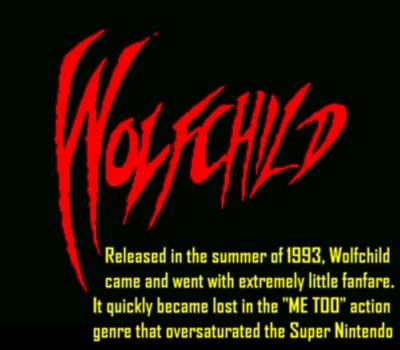
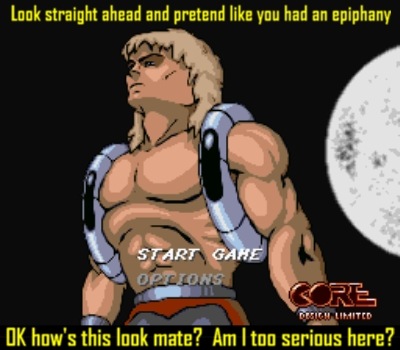
THE WEAPONS
1. BASIC
This is Saul’s standard shot each time he transforms into a werewolf. It’s not very powerful but it gets job done on regular enemies. It has unlimited ammo so you never have to worry about conservation. Serviceable but you’ll want something with a little more oomph soon.
2. DUAL SHOT
Not surprisingly, it can fire two shots at once.
3. ARC SHOT
My least favorite weapon. Why? Your shots arc at an angle. Usually I find it most effective firing straight ahead but you can’t do that with this gun because, er, well, it’s the freaking arc shot. But it comes in handy when the enemy is slightly below Saul.
4. BOOMER
Surprise surprise, it acts like a boomerang. It provides you some decent coverage and protection. I also like the way it looks. It’s only appropriate for a wolf who howls at the moon to have a moon-shaped projectile, eh?
5. MÉNAGE À TROIS
One of my favorite weapons in any action game is the classic spread shot. Thanks, Contra. Functional and convenient, the spread shot always makes me feel in total control of my destiny. It’s highly useful as you can see here. No longer do you have to carefully time your leaps. Simply fire away from a safe position. It might not be super strong, but what it lacks in firepower it makes up for with sheer coverage.
6. HOMER
This weapon definitely doesn’t elicit a “D’OH!” Not only can you fire multiple shots at once but they automatically lock on to the nearest enemy target. It’s a shame though that it doesn’t come into play until late in the game and there aren’t many opportunities to get this power-up.
7. FLAMER
Hmmm… my two favorite power-ups are FLAMER and HOMER. FLAMING HOMER, anyone? This shot goes through ANYTHING and can only be stopped by hitting scenery that is unbreakable. This is awesome because not only does it save you ammo but you can fire a shot, run all the way across the screen and watch the chaos unfold before your eyes.
8. PLASMA BALL
This crazy shot bounces across the screen from wall to wall and ceiling to floor. A wild card, it’s not very reliable but it’s fun rolling the dice.
NULLIFY!
A cool thing about Wolfchild is that your shots can cancel out the enemy’s shot. This gives the game an extra layer. Your power-ups not only serve as offensive tools of destruction, but they can also act as defensive buffers. Nothing is cooler than nullifying a bad guy’s shot only to shoot him down the very next second. I wish more games did this.
TIME TO GO SAVE THE OLD MAN!
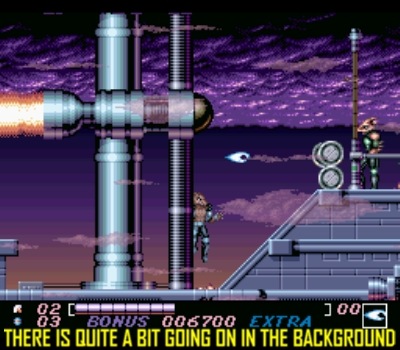
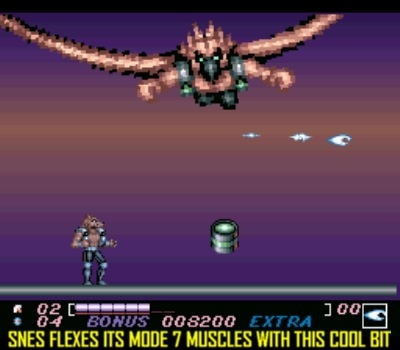
Morrow’s dramatic entrance is a bit reminiscent of NES Karnov…
Karnov was one of my most favorite NES games back in the ’80s ![]()
![It'd be nice if more games went out on a limb [... -Ed.]](http://rvgfanatic.com/wordpress/wp-content/uploads/2017/02/Wolfchild43.jpg)
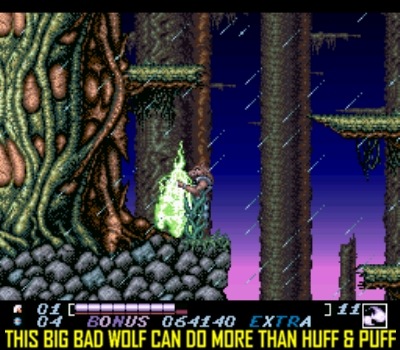
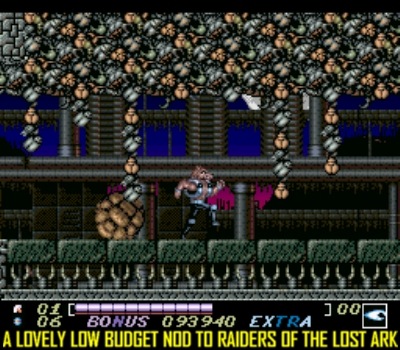
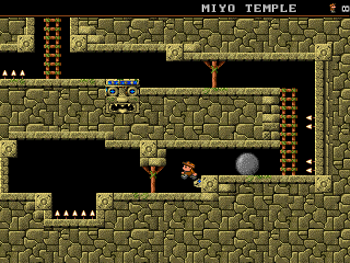
Science experiments gone horribly wrong hide before bursting out and giving chase. Creepy. Reminds me of all those black and white monster B-movies from the 1950s.
WHAT THE CRITICS SAID
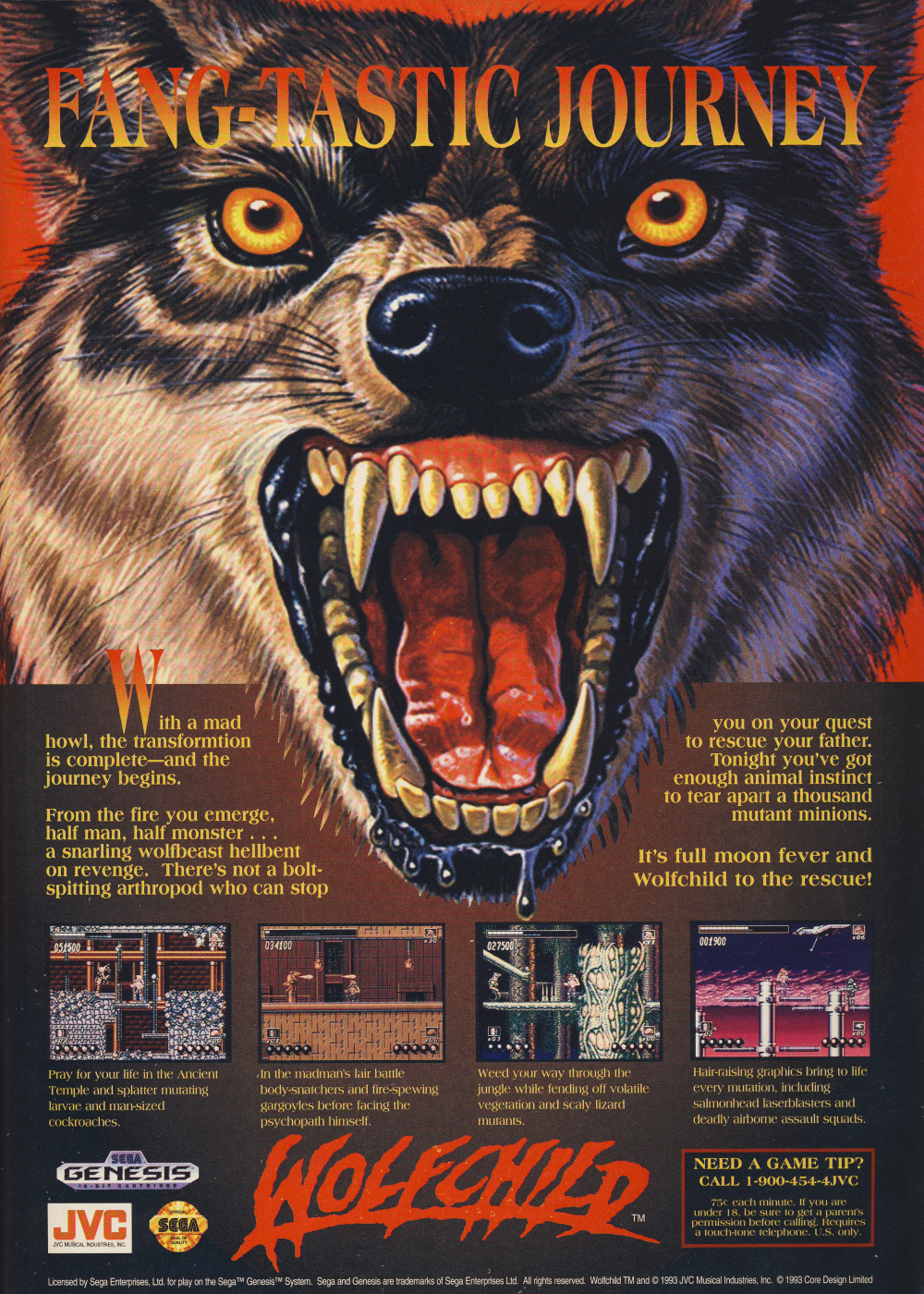
Despite having seven different console variations, Wolfchild on the SNES flew under the radar. There was no preview of the game in either EGM or GameFan. So when EGM dropped the tiny review blurb it was like “Huh, what game is this?” To make matters worse, the SNES version only received ONE score rather than EGM’s traditional four. That’s because EGM was going through a phase where all their side reviews (the small ones tucked on the side) were judged by one person only. So a game reviewed this way sort of lived and died on just one man’s opinion. Wolfchild only managed to garner a measly 5 and was quickly dismissed in a very short review. Ah, such is the life for obscure video games, eh?
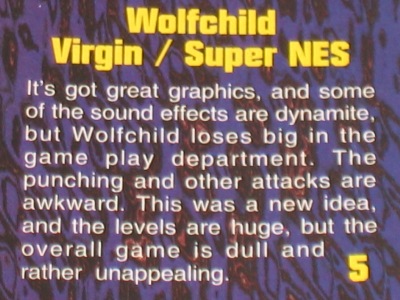
CLOSING THOUGHTS
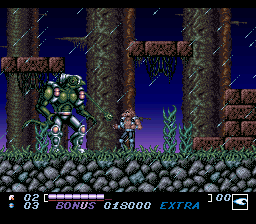
One of the best feelings as a retro gamer is beating a game you’ve been curious about (since you were a kid) in one sitting. There’s something undeniably satisfying about that. It’s like killing two birds with one stone. Wolfchild was one of over 100 games I wanted to play back in the day but never did. I remember thinking back in the ’90s when I saw the ad that it didn’t seem like a great game but it looked decent enough. It’s always nice when you find out, years later, that your gut feeling was right all along. There isn’t anything in particular that stands out about Wolfchild. The graphics, sound and gameplay are all slightly above average. It does nothing particularly well, but it doesn’t do anything horribly bad. There are only five short levels, with each level containing two or three zones. The game can be beaten in about an hour. The levels aren’t inspiring but they’re enjoyable enough. If you’re a Super Nintendo diehard who loves action games then Wolfchild may be worth checking out. I won’t go as far as a thumbs up; I’ll go with mildly recommended.
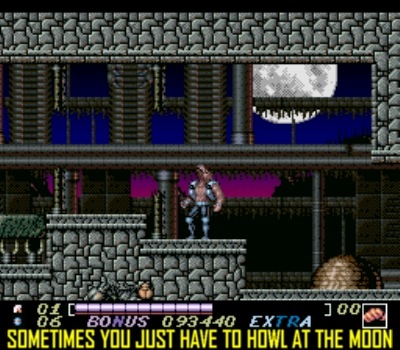
Back in December 2008 I had the strangest urge to finally play Wolfchild. It’s always a blast to quell a 15+ year curiosity. I went on to beat Wolfchild in an hour. While it wasn’t a great game by any stretch of the imagination, it was highly satisfying. Few things after all rival the sheer thrill of beating a childhood curiosity on your very first try. I didn’t like however that you can only hold one weapon at a time — it would be a lot better if you could cycle through the weapons. I also didn’t like that each gun shares the same ammo. It definitely didn’t take full advantage of the SNES capabilities. Nevertheless, Wolfchild is decent enough to entertain you for an hour or two. If Super Mario World is gourmet award winning 5-star pizza, then Wolfchild is the equivalent of frozen pizza. It’s cheap, easy and not as good as the real deal, but it can satisfy your midnight craving in a pinch. Just as the song goes: I’m lost in a crowd and I’m hungry like the wolf. Similarly, Wolfchild was lost in a sea of contenders. It finds itself somewhere in the middle of the, er, “pack.” ![]()
Graphics: 6.5
Sound: 6
Gameplay: 6
Longevity: 5
Overall: 6.0
RVGFANATIC EXCLUSIVE: Simon Phipps Interview
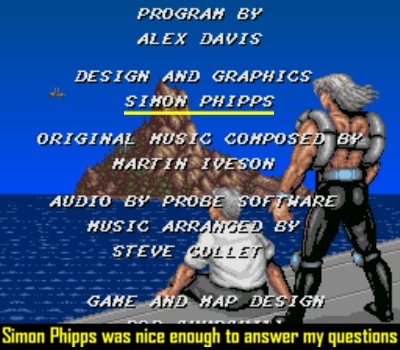
STEVE: Were you into video games growing up? What were some of your favorites, whether arcade or console?
SIMON: I was fortunate enough to be 12 years old when Space Invaders first appeared in the arcades in 1978 so I’ve been privileged to experience pretty much all of video game history watching those early coin-ops make their way into homes and evolve into the amazing experiences we play today. So, yes, growing up, I have fond memories of pushing 10 pence coins into those early arcade cabinets. Most notable ones being playing table-top Galaxians at a local leisure centre, getting a callus on the inside of my right index finger from playing way too much Ms. Pacman during the summer of 1982 on a vacation to Ontario, Canada, being physically shaken the first time I played Sinistar in a local arcade in my home town of Nottingham when the machine boomed ‘RUN COWARD!’ (I didn’t know it could speak) and many lunchtimes playing the obscure side scroller Vastar in the back of a local record store with my buddy (and later colleague at Core Design), Terry Lloyd.
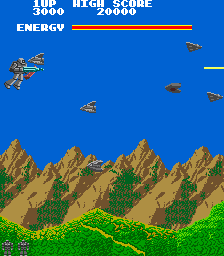
But interestingly the reason I got a computer at home wasn’t because I wanted to play games, it was because I’d always been fascinated with animation as a kid and computers were a way into making my art move.
I bought my first computer in May 1982 — a BBC Model A Microcomputer and started to teach myself BASIC and 6502. Of course, computers being interactive, making controllable animating characters was the next step and soon I found myself making games.
Of course, I played a few along the way — the very first to really blow my mind, being David Braben & Ian Bell’s Elite on the BBC in 1984. I progressed from the BBC to an Amstrad CPC464, then an Atari ST, always learning, trying new stuff, and the first piece of dedicated games hardware I ever bought was a Japanese Mega Drive with a copy of Insector X and Strider…
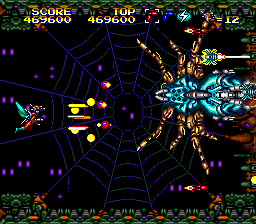
STEVE: How did you break into the video game industry?
SIMON: It actually grew out of having my BBC Micro. I started writing games for myself and by mid-to-late 1983 my school friend, Stu Gregg (who would also go on to work with me later at Core) encouraged me to send the game I was working on off to a few publishers as he thought that what I was making was good enough to be seen by the wider world. I put my game on a tape cassette and sent it out. Within a few weeks I was contacted by Leeds-based publisher ‘Micro Power’ who sent me a great letter saying they’d publish if I made a few changes. I did, and so, by the age of 18, while still at school, I had a game (a single-screen platformer called Jet-Power Jack) in the Top 10 of the UK Games Charts.
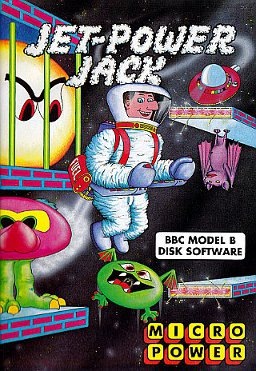 I continued to work on my education and at 21 I finished my Computer Studies course and went to do a job writing BCPL code for a desktop publishing firm. I sat in a cubicle for about 5 months writing code and one evening, my buddy Terry (Lloyd), who’d since joined the games industry, working as an artist for Gremlin Graphics gave me a call. They needed someone who could give them a helping hand drawing art for ‘Masters of the Universe: The Computer Game’ for the Amiga and Atari ST and Terry asked me if I’d be interested. I said yes, so turned up with a disk showing what I could do and they offered me a job.
I continued to work on my education and at 21 I finished my Computer Studies course and went to do a job writing BCPL code for a desktop publishing firm. I sat in a cubicle for about 5 months writing code and one evening, my buddy Terry (Lloyd), who’d since joined the games industry, working as an artist for Gremlin Graphics gave me a call. They needed someone who could give them a helping hand drawing art for ‘Masters of the Universe: The Computer Game’ for the Amiga and Atari ST and Terry asked me if I’d be interested. I said yes, so turned up with a disk showing what I could do and they offered me a job.
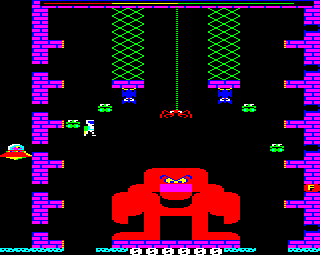
It meant a pay cut, and back then, the games industry really was in its infancy, so I consulted my then fiancée, Jayne (we’ve been married now 25 years) as to what she thought. We agreed to ‘give it a go’ thinking that if all else failed I could go back to the world of serious computing.
Well, it’s now some 27 years later and I’m delighted to say that I have the privilege of being an artist, coder and designer, having done all manner of amazing stuff working with some great people on a huge variety of games.
If I could go back and show my younger self all the cool stuff I’ve gotten to do, I think it would have blown my mind…
STEVE: There were so many different versions of Wolfchild. For a game that didn’t necessarily receive a lot of coverage, it’s pretty amazing to think about how many systems got a variation of it. Which systems, other than the SNES, did you work on with Wolfchild?
SIMON: I think it would be fair to say… ‘All of them.’
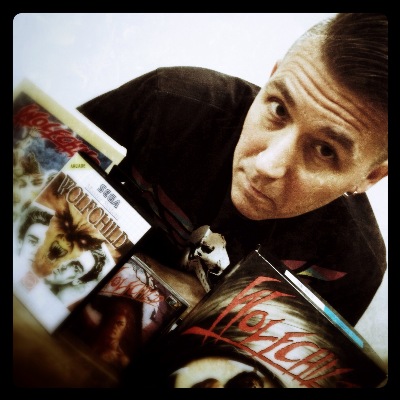
Core was in a phase where it made business sense to get our games on as many platforms as possible. So, yes, I worked on the Atari ST and Amiga originals. We then ported it to the SEGA Mega Drive, SEGA Mega-CD, the SNES and finally the SEGA Game Gear and SEGA Master System… by the end of them… I was DONE!
STEVE: Have you been able to play all variations of Wolfchild? Where does the SNES version rank in your opinion?
SIMON: Yes, while we were developing them.
The original version was on the Amiga, we ported down to the Atari ST which struggled a little since it had no hardware scrolling and I had to bring all the graphics down to work in one 16 color palette.
We then followed that up with the SEGA Mega Drive and Mega-CD versions, which were cool because we got to build additional maps for the Mega-CD and these versions were the first console games I’d ever worked on.
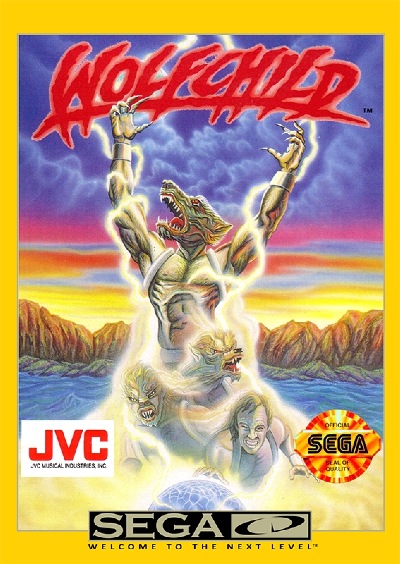
Then came the SNES — which played the same as the other versions but has the best graphics, since the SNES hardware allowed for many more colors and palettes.
Finally we down-converted everything to the SEGA Game Gear and Master System which were a fun technical challenge, since, by that time I had all the art from all the versions and the trick that Sean Dunleavy (who coded these versions) and I had to pull off was cramming it all down into the tiny console. But within the limitation of the devices we managed to pull it off.
STEVE: Where did the concept of Wolfchild come from? What were some of your inspirations? How big of an influence was Altered Beast to you?
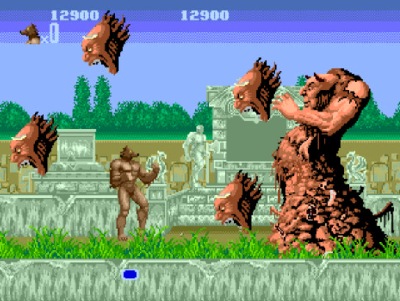
SIMON: I got to Wolfchild after spending about 4 years making cartoon platform games. The simple fact was, that I made one, and then was asked to do another, and while fun, the artist in me was craving to try something a bit more serious with more realistic characters.
I was massively influenced by Strider, which I thought at the time was quite amazing. Yes, Altered Beast gave me the idea of taking a hero from human to a super-powered werewolf… but the thing that really inspired me, as crazy as it sounds, was a belt buckle…
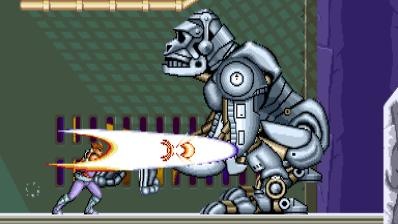
One of my colleagues at Core, Bob Churchill (who worked on such titles as Chuck Rock) was hugely into bands like The Cult during the late ’80s / early ’90s and often wore a belt with a buckle that had the word ‘WOLFCHILD’ in cut-out silver letters on it.
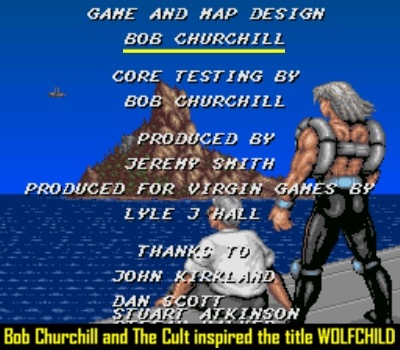
To this day, I have no idea what it meant, but that ‘title’ just worked for me, so all those things came together to make the game.
Other influences would be Capcom coin-op art of that era (hence the Manga-like characters, which back then still hadn’t become mainstream so they were cool and exotic), the graded metallic art of the Bitmap Brothers games and from a story point of view, all those half-human-half-animal creatures draw from The Island of Doctor Moreau (hence the main characters’ surname: Morrow).
STEVE: Ahhh, now looking back at Wolfchild with that inspiration in mind, I can see the Strider influences. Wolfchild was kind of an obscure game despite having seven variations. Were you disappointed that magazine publications such as EGM and GameFan didn’t cover it much?
SIMON: At the time, being in the UK, magazines like EGM and GameFan never really made it across the Atlantic. We made games for the UK market and it was only over time, as consoles started to go global that we started thinking beyond our shores.
The big problem Wolfchild had was that it was never built first for console hardware. We made a game for the Amiga and the Atari then some time after it had been finished, when the opportunities came around, got to port it over to the various consoles.
As is always the case, if you do not build something for a specific console / piece of hardware (or at least go in bearing that in mind before you embark on a multi-format project) you’ll never take advantage of its full potential. In the case of Wolfchild, the other consoles had dedicated sprite hardware, character-map based scrolling playing fields and some funky scaling routines on both the Mega-CD and SNES that we were never going to be able to take as much advantage of, coming from a game that mostly used software-based sprites and was originally intended for just 2 formats.
That said, the problem still exists in the industry today — if you look at the best and most successful Nintendo games, for example, they’re always the ones that are built for the hardware and take advantage of not only its graphics hardware but its unique controls too. When working on multi-format titles it’s a constant drive to make sure you’re thinking about utilizing the various platforms’ unique features while trying to make the best core game possible.
STEVE: Looking back, how do you feel about the SNES version?
SIMON: It was a great learning experience because it taught me all about making graphics in the highest resolution and widest palette range possible and then scaling down and reducing colors to whatever the target machine needs.
You see, I started Wolfchild on the Amiga — I had a single palette of 16 colors for my main character, 8 colors for all the bad guys and 8 colors for the background art (or 4? It wasn’t many…)
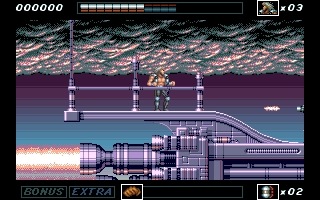
When we moved up to the SEGA Mega Drive and Mega-CD the increased number of hardware palettes meant that I could add more color to the various elements of the game — that was okay, it was ‘doable’ — bad guys had their own 16-color palette, foregrounds another…
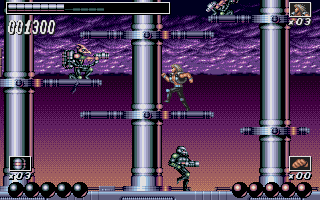
Then after that the SNES came along and the sheer number of palettes that were open for me to use, plus the resolution of the color palettes BLEW MY MIND. I can remember distinctly sitting with an art package on the PC adding extra detail and colors to all the graphics that I’d already added detail to for the SEGA versions and thinking — I wish I’d known I’d be doing this 2 years ago…
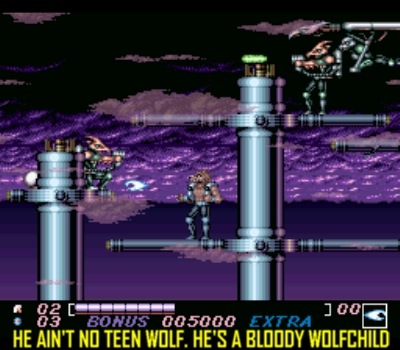
From then on, I’ve learned to draw everything as big as possible, in as many colors as possible and then scale down. That’s proven very useful when I’m working on some of my personal art commissions — I’ll guarantee a client will come back to me asking if they can have a slightly larger version of a logo or a wider format of print. Thanks to software like Photoshop, Manga Studio and Anime Studio (the latter two being resolution independent) I can’t see myself adding extra pixel details to anything again.
STEVE: Any regrets on the SNES game? Were there any ideas you wanted to implement, but didn’t, or couldn’t, for whatever reason? i.e. NoA’s strict family image back in those days…
SIMON: Only that we didn’t get the opportunity to make the game from the ground up on the SNES — it had to be the third-in-line conversion of our Amiga game. If we’d been making a title from the ground-up on SNES, that would have been a completely different story — we’d have thrown every hardware trick in the book at it.
As goes NoA and its approach — never a problem. I never intended to make the game anything other than the Capcom-inspired action platformer it was.
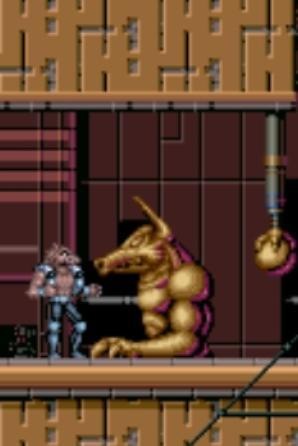
In later years, I worked on Shadow Man on the Nintendo 64, and for its time we really pushed the boat out in terms of horror and maturity and had no problems there — and even in ultra-conservative Germany where we had to change all the blood to green the classification board understood that in that game all the characters, however humanoid in appearance were all monsters, so we got the opportunity for a release there where other titles didn’t.
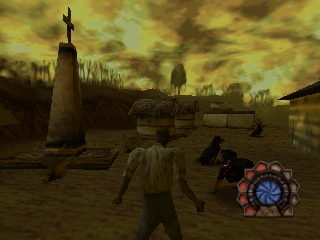
STEVE: Did you ever consider making a Wolfchild 2?
SIMON: No, after about 2 years of making it and then remaking it for another 18 or so months for various other formats, I was exhausted and needed to do something else.
It’s interesting to ponder what a modern version would be like though — I guarantee that in a world in which Chris Nolan’s excellent Dark Knight exists, it would have to be a very different… beast…
STEVE: In the end credits, who exactly is The Man On The Stairs? I like to imagine there’s a pretty decent story behind this…
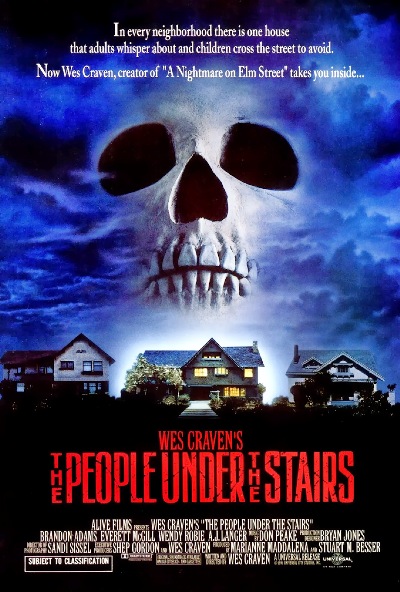
SIMON: Crikey — that’s something I’ve not thought about for about 20 or so years…
The story behind that is that Chris Long (coder on Chuck Rock, Chuck Rock II and a whole heap of other classic Core games) used to draw ridiculous little cartoons all the time while he was working. They were intentionally crudely drawn but quite hilarious. One of which he called ‘Man on the Stairs’ — basically a guy standing sideways on a set of stairs one foot on one step, the other foot on the step above staring out of the page with a manic leering grin. This would get drawn everywhere — I don’t think anyone’s notepad was safe. So, yes, Chris’ art got an obscure name-check. And you’re the first person that’s ever asked me about it.
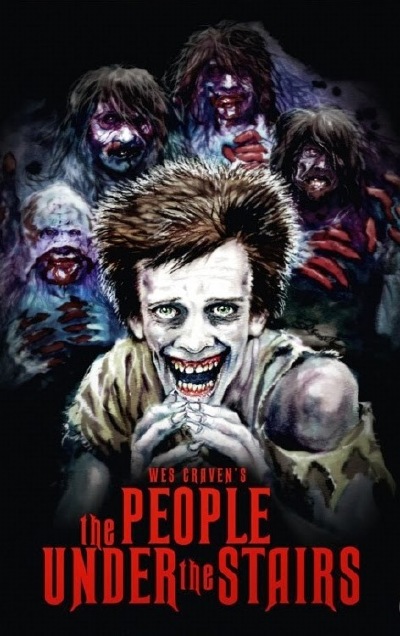
STEVE: Great backstory! I love those little neat obscure stories lost to time… I am honored to be the first one to ever ask. Speaking of backstories, do you still keep in touch with any of the Wolfchild team members? Any interesting “behind the scene” stories that you’d like to share?
SIMON: Yes, John Kirkland who wrote all the 6800 versions (ST, Amiga, Mega Drive) went to school with me — he no longer works in the industry, but we keep in touch.
One memory that I’ll never forget was one night John and I were working on the game until about 1 AM as we had a journalist coming to visit the following day to do a preview on the Amiga version. We had a bug — a horrible, horrible bug in the scrolling code that neither of us could figure out. We stared at it for hours, trying to get our heads around what was going wrong until way past midnight and eventually had to throw in the towel and go home exhausted. We went home, got some sleep, came in at 8:30 AM the following day, took another look at the code and fixed it by 9 AM! That taught me a lot about taking a step back — sometimes when you’re banging your head against a wall the only way to make things better is to just stop and walk away. And get some sleep.
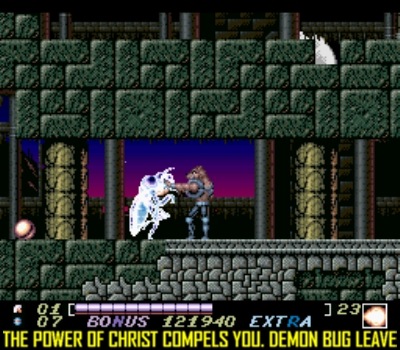
STEVE: Ha, good story and a great lesson learned! Yes, sometimes we just need to step away from something and get a good night’s rest. The SNES manual of Wolfchild had a pretty detailed storyline with some striking black and white comic book-like drawings. Who was responsible for the storyline and drawings? Personally, I found both the story and drawings to be quite riveting.
SIMON: Cool, thanks. I came up with the storyline — I needed some kind of backstory to justify super-powerful genetic mutations and something to motivate our hero into going after the bad guy. Where precisely it came from, I’m not sure, but it was the first game I’d ever made with a substantial graphical intro (which were quite en vogue at the time after the Psygnosis games made such an impact with their ‘intro disks’).
As to the illustrations — I drew them all for the Amiga and Atari ST manuals. SEGA had their own artist reinterpret them for the Master System/Game Gear ones. As for the illustrations — I drew them all for the Amiga, Atari ST and SNES manuals. Back at Core since we were our own publisher we had freedom to make as much or as little of the manual as we liked, so I just picked up my pencil and made the most of the opportunity.
STEVE: Tell me about how you came up with the protagonist’s design.
 SIMON: The design of Saul Morrow (the hero) was out of necessity — I decided I didn’t want our hero to do the full ‘Altered Beast’ transformation of going from a man in his underwear to a full-on hairy werewolf — I wanted to keep something common between both forms and have the reason for the transformation to be something… ‘science-y.’ I also needed to keep down the amount of memory for animation frames; it made sense to share the same pair of legs between both forms (especially as I needed variations for running up and down all those slopes). The big silver metal ‘hoops’ around Saul’s shoulders gave me something common to share between both his forms but left me enough skin to show the difference between his human and wolf-forms. Finally, his hair is long and white/blonde because I wanted something that looked a bit wild and unlike the rest of the muscular buzz-cut video game characters of the time, and I tried black hair but that merged with all the backgrounds so I had to lighten it.
SIMON: The design of Saul Morrow (the hero) was out of necessity — I decided I didn’t want our hero to do the full ‘Altered Beast’ transformation of going from a man in his underwear to a full-on hairy werewolf — I wanted to keep something common between both forms and have the reason for the transformation to be something… ‘science-y.’ I also needed to keep down the amount of memory for animation frames; it made sense to share the same pair of legs between both forms (especially as I needed variations for running up and down all those slopes). The big silver metal ‘hoops’ around Saul’s shoulders gave me something common to share between both his forms but left me enough skin to show the difference between his human and wolf-forms. Finally, his hair is long and white/blonde because I wanted something that looked a bit wild and unlike the rest of the muscular buzz-cut video game characters of the time, and I tried black hair but that merged with all the backgrounds so I had to lighten it.
STEVE: I like the design of Saul. You’re right, the buzz-cut pervaded the scene back then; it was nice to see a hero with long blonde hair for a change. How come on the SNES box art cover though he has black hair? Was that just a honest mistake that no one caught?
SIMON: Nope — this is one of those cases where I’m afraid the artist who did the box art wanted to do his own thing. I drew out a brief sketch detailing what Saul’s costume in the sprite looked like when scaled up. That I’m afraid to say, was dutifully ignored. I complained about it, but ‘it was too late.’ Years later I was on a plane to the US when I picked up the in-flight magazine and saw on the back page an Yves St. Laurent Eau de Toilette ad for ‘Kouros’ that bore a rather remarkable resemblance to what went out on the box… um… yeah…
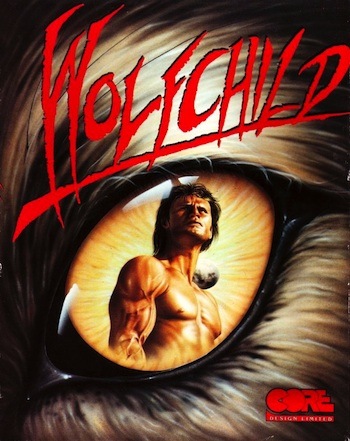
STEVE: There were eight weapons for Saul to use. I enjoyed their versatility, although I wish they didn’t all share the same ammo. Do you have any insight to share about any of Saul’s weapons… whether it’s design or where you drew inspiration from? I personally enjoy the Homer and Flamer the most. The former because you don’t have to be precise and the latter because that sucker blew through almost everything on the screen and could kill multiple enemies.
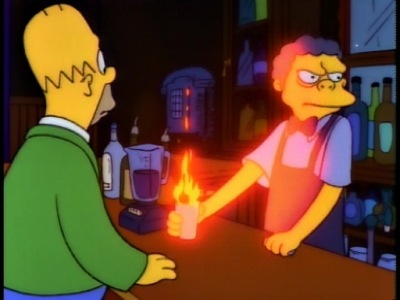
SIMON: I basically wanted to do every kind of possible firepower I could in the game — big shot, triple shot, homing shot, etc. I guess games like Side Arms and Gradius in the arcades were some influences there. The reason for sharing the same ammo? Well, on Atari and Amiga we only had a limited number of joystick buttons to play with, so we made a game that worked for them and the rest of the conversions inherited the simplistic controls and weapon power ups simply changed the type of shot… a thing if I recall correctly, I’d played around with on my earlier Atari / Amiga game, Switch Blade.
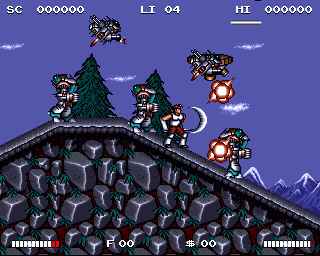
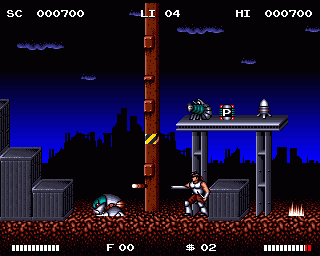
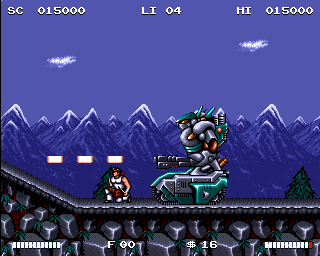
STEVE: When Saul throws down a smart bomb, the screen pixelates. I thought it was pretty cool how everything on the screen would pixelate like crazy except for the character sprites and any projectile shots. The debris on the final boss fight is not pixelated either, which makes for a neat visual when you throw down a smart bomb. Talk about working on that aspect.
SIMON: The smart bomb effect is one of those cases when doing a conversion to a different platform where you’re trying to be seen to be using its hardware.
So, for example, in more modern times, taking a game over to Wii U, your first priority is getting gameplay on Wii U Gamepad’s touch screen, at the launch of PS3 it would have been being encouraged by Sony to use the tilt controls on the Sixaxis, or, prior to Microsoft’s about-face on the Kinect, getting gesture and voice commands into an Xbox One game.
You always have to do that — the customer (rightly) wants a game that uses the console’s unique features as much as possible, and the console manufacturer definitely wants that to happen.
So, doing a conversion, (often, in those old days, against a tight schedule), you’re looking for as many ways to get unique uses of the hardware in without impacting the time you have to complete the conversion.
With the smart bomb effect in Wolfchild, Alex (Davis) realized we could use the SNES’ signature pixelation effect in certain circumstances and suggested we put it in there. As to why the sprites don’t pixelate — that’s a limitation of the hardware — the character playing fields were possible to pixelate, the sprites didn’t do that.
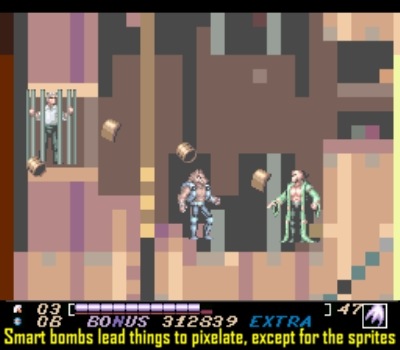
STEVE: Karl Draxx (no relation or inspiration drawn from Guardians of the Galaxy‘s Drax the Destroyer, I presume) was an interesting villain. How did you come up with his name and design? I remember after beating his human form he transforms into a monstrous wolf. I always thought that final design was pretty cool for Draxx.
SIMON: Y’know, I just came up with a name that sounded suitably comic book and tried to come up with something that looked right… (I read a lot of Marvel’s Warlock strip in the late 1970’s so it’s possible that name rattled around in my head and came out years later). And of course, he had to turn into a massive-super-humongous-wolf-beast for the showdown, didn’t he?
STEVE: Did you work on the Dreamcast version of Shadow Man as well? I always thought that the premise of Shadow Man was awesome. Love the title and atmosphere of that game! Were you the one who created Shadow Man’s design and story? Not to deviate too far away from Wolfchild but I gotta ask, especially since it’s Halloween season: what were the inspirations for Shadow Man? It gave me a Candy Man Tony Todd vibe. I think a new Shadow Man game today could do very well…
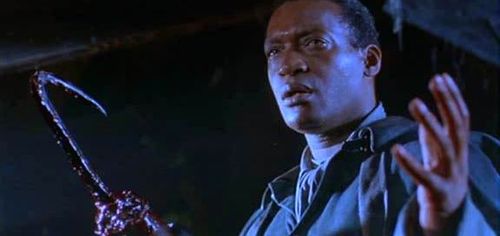
SIMON: Yep — all versions of Shadow Man, as lead designer. In the wake of Turok’s success, we got the opportunity from Acclaim Studios Teesside to do an adaptation of one of Acclaim’s other comic-book properties. The coolest by far however was Shadow Man (the title had recently been rebooted by Garth Ennis and Ashley Wood) and although the comic when we got a hold of it was only a handful of issues into its rebooted run, it sure had potential. Mike LeRoi, Nettie, Jaunty and the Deadside Gates were the creations of Messrs Ennis and Wood, myself and my partner-in-crime at the time, Guy Miller were responsible for the rest. The premise we came up with was “What if all the bad people in Deadside (the World of the Dead) decided that they wanted to come back?” and using that as a springboard we spent the next 2 or so years exploring the wildest of dark places and cramming them all into an N64 cartridge and eventually a Dreamcast. Inspirations came from all over the place — Pieter Bruegel’s painting The Tower of Babel was our starting point for the Asylum — the citadel of killers in Deadside, films and TV such as Lance Henriksen’s show Millennium, the Clive Barker movies like Hellraiser and Nightbreed, Jacob’s Ladder, Silence of the Lambs, Eraserhead, Cape Fear all were influences.
It was a really fun thing to work on — I’m not into horror movies that much, but I did enjoy the subversive intellectual challenge of coming up with stuff that I knew would mess with folks’ heads. It’s surprising sometimes how putting a handful of incongruous and often innocuous elements together can really affect people and evoke a strong reaction. I’m not doing it in video games any more, but I still like doing that sort of thing in the paintings I make for myself.
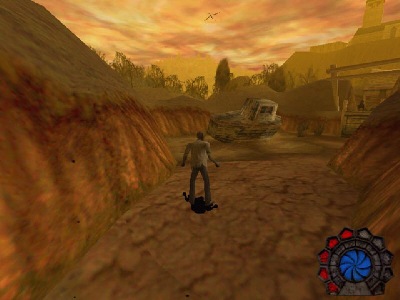
STEVE: Finally, last but not least… what is Simon Phipps up to now?
SIMON: Well at the beginning of 2014 I decided to leave my Designer job at Criterion Games / Electronic Arts and join the world of independent game making, to get myself back into coding after 20 years’ absence.
Since then I’ve hooked up with the wonderful and talented guys at the newly-formed Three Fields Entertainment and I’m pleased to say that I’m working on a cool new (retro-inspired) game as lead coder, designer and artist (which is why, when asked what I’d like my new job title to be at the company I came up with ‘O.T.T.’ — or, Original Triple Threat… I’ve met enough CEOs and CTOs over the years. I’m not one of those but OTT? Guilty as charged…)
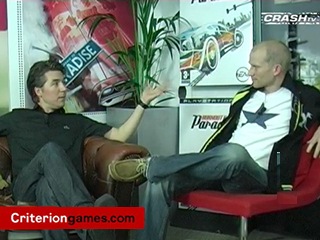
I hadn’t realized how much I’d missed coding after having to give it up at the start of Wolfchild, so it’s great to be back, solving problems, learning heaps of new stuff.
The folks at Three Fields are super supportive and are giving me such creative freedom on the new game while collaborating with me to push it and make it the best it can be. As to when it will be out — well, after many years of cutting features on games and pushing teams to meet enforced deadlines, I’m pleased to say that Three Fields mantra is ‘when it’s ready.’ If anyone’s interested in what other art I’ve made and games I’ve worked on, they can visit my website.
—
Thanks for your time, Simon. It was fun.
I wish you all the best on your future projects.
-Steve
On November 29, 2014, Simon was sent a link to my review and our interview. He had the following to say…
—
Great fun, Steve — what a wonderfully quirky presentation of the game — loads of work went into that and I love the whole personal story that you’ve brought to it. Really describes your journey to the game, how we hooked up and where we are now. Thoroughly enjoyed it. Take care. -Simes
—
Wow, that made my day. Thank you again, Simon. It was a lot of fun ![]()
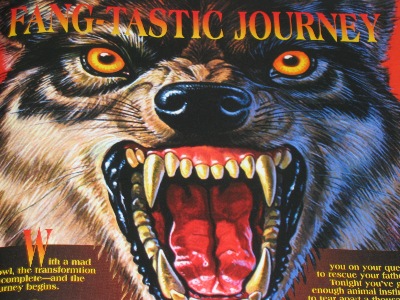
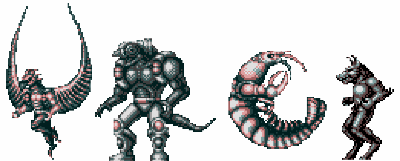
LINKS OF INTEREST:
HG101’s Wolfchild topic (look for my posts under, er, Steven)

